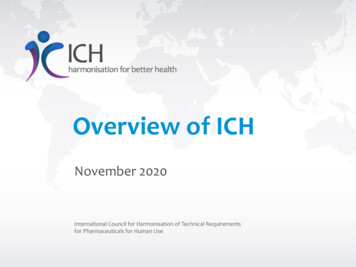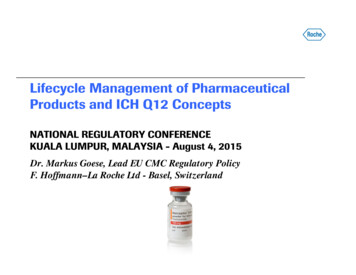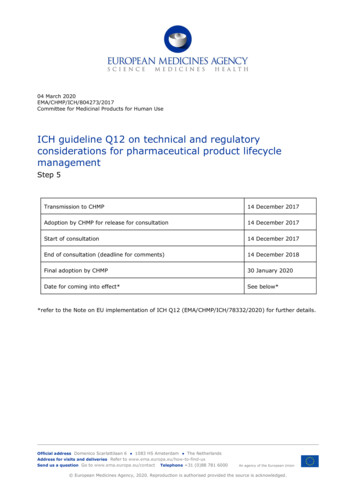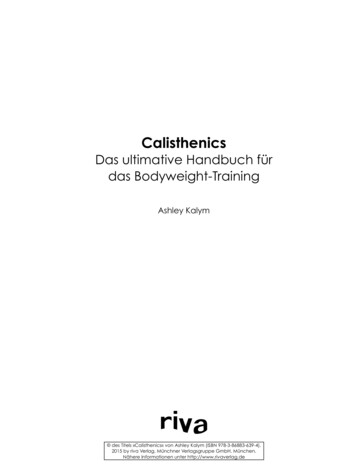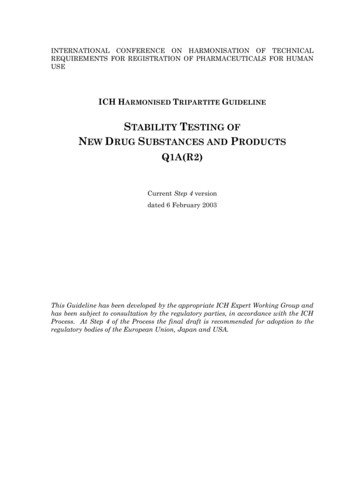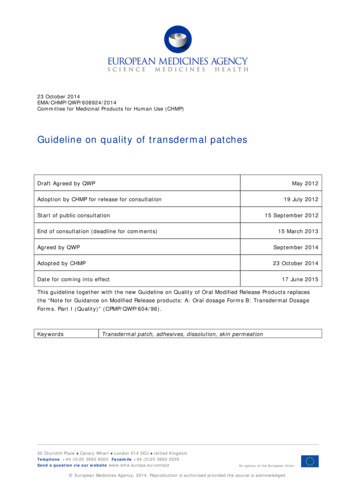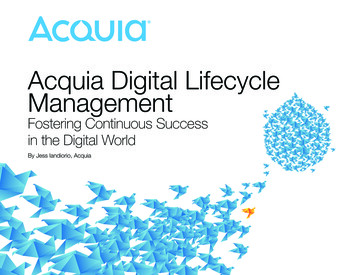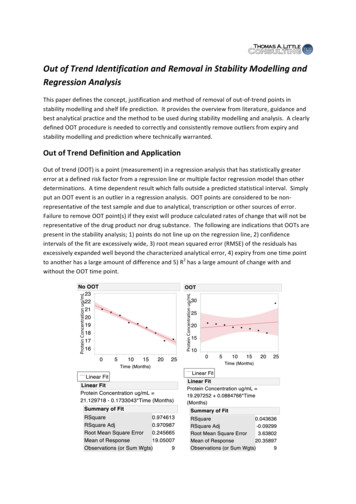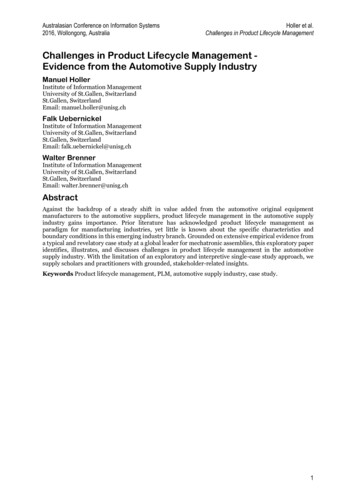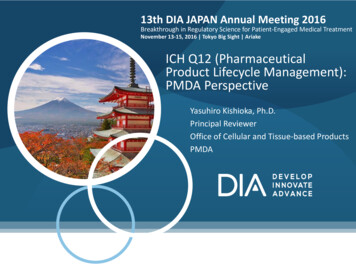
Transcription
13th DIA JAPAN Annual Meeting 2016Breakthrough in Regulatory Science for Patient-Engaged Medical TreatmentNovember 13-15, 2016 Tokyo Big Sight AriakeICH Q12 (PharmaceuticalProduct Lifecycle Management):PMDA PerspectiveYasuhiro Kishioka, Ph.D.Principal ReviewerOffice of Cellular and Tissue-based ProductsPMDA
DisclaimerThe views and opinions expressed in the followingPowerPoint slides are those of the individual presenterand should not be attributed to DIA, its directors,officers, employees, volunteers, members, chapters,councils, Communities or affiliates, or any organizationwith which the presenter is employed or affiliated.These PowerPoint slides are the intellectual property ofthe individual presenter and are protected under thecopyright laws of the United States of America andother countries. Used by permission. All rights reserved.DIA and the DIA logo are registered trademarks ortrademarks of Drug Information Association Inc. Allother trademarks are the property of their respectiveowners. 2016 DIA, Inc. All rights reserved.2
BackgroundFrom ICH Q12 Concept PaperICH Quality Vision 2003Develop a harmonised pharmaceutical quality system applicable across thelife cycle of the product emphasizing an integrated approach to quality riskmanagement and scienceICH Q8 Q11, Points to Consider, Q&As[Current Situation]The envisioned post-approval ‘operational flexibility’ has not been achieved asthe main emphasis at ICH to date has focused on early stages of the productlifecycle.The lack of harmonised approaches for technical and regulatory aspects forlifecycle management can hinder innovation and continual improvement.ICH Q12: Pharmaceutical Product Lifecycle Management 2016 DIA, Inc. All rights reserved.3
Objectives and ScopeFrom ICH Q12 Concept PaperObjectives include: Provide a framework to facilitate the management of post-approval Chemistry,Manufacturing and Controls (CMC) changes in a more predictable and efficientmanner across the product lifecycle Optimization of industry and regulatory resources Support innovation and continual improvement and help to assure drug productsupplyScopePharmaceutical products, including currently marketed chemical, biotechnologicaland biological products. (However, each regulatory authority will decide whethergeneric medicines can be included in the scope of this guideline.) 2016 DIA, Inc. All rights reserved.4
Issues to be addressed in ICH Q12From ICH Q12 Concept PaperRegulatory Dossier Explore the development of a harmonised approach to “regulatory commitments” for inclusion in the guideline. Suchapproaches could enable post approval changes that facilitate continual improvement and encourage the adoption ofinnovative technologies. Delineate the appropriate level of detail and information necessary for regulatory assessment and inspection in thedossier, in order to create a more enabling post approval change management system.Pharmaceutical Quality System (PQS) aspect Establish criteria for a harmonised risk-based change management system based on product, process and/or clinicalknowledge that effectively evaluates the impact of change on quality, and, as applicable to safety and efficacy. Clarify expectations and reinforce the need to maintain a knowledge management system that ensures continuity ofproduct and process information over the product lifecycle.Post-Approval Change Management Plans and Protocols Introduce the concept of a post-approval management plan that can be used to proactively identify post-approvalchanges and the mechanism to submit and assess these changes by regulatory authorities (Assessors and Inspectors) Establish criteria for post-approval change management protocols that can be adopted by the ICH regions (enabling aharmonised proactive approach for lifecycle management) Encourage enhanced product development and control strategy approaches (Quality by Design (QbD)) providingopportunities for scientific and risk based foundations for post-approval change management plans. 2016 DIA, Inc. All rights reserved.5
Regulatory Commitments/Established ConditionsAlthough the Common Technical Document (CTD) format has beendefined for a marketing application, there are no previouslyharmonised approaches to defining what changes would require aregulatory submission.Established Conditions are legally binding information (or approved matters) considerednecessary to assure product quality. are contained in a regulatory submission, proposed by the applicant,and approved by the regulatory authority. As a consequence, any change to Established Conditions necessitates asubmission to the regulatory authority that is consistent with regionalregulations or guidance; or as agreed upon during review and approvalof the marketing application. 2016 DIA, Inc. All rights reserved.6
Approved Matters and Established Conditions 2016 DIA, Inc. All rights reserved.7
Japan’s Effective/Efficient/Flexible Quality RegulationModule 1(Application Form)Legally bindingModule 2 (QOS)Module 3Not-Changeable withoutregulatory procedures (PCA/MCN) 2016 DIA, Inc. All rights reserved.Changeable without regulatoryprocedures (PCA/MCN)8
Japan’s Effective/Efficient/Flexible Quality RegulationModule 1(Application Form)Legally bindingModule 2 (QOS)Module 3Not-Changeable withoutregulatory procedures (PCA/MCN) 2016 DIA, Inc. All rights reserved.Changeable without regulatoryprocedures (PCA/MCN)9
Review Process of MAA with document flow-Focus on CMC- 2016 DIA, Inc. All rights reserved.10
AF and Review/Inspection-Focus on post-approval change-inspectionAFreview11 2016 DIA, Inc. All rights reserved.Modified from draft Q12 document
Japanese Application FormMHLW 2016 DIA, Inc. All rights reserved.MAHs12
Japanese Application Form/Approved MattersApplication Form (AF), found in Module 1.2, is a legallybinding document in Japan.Essential elements to ensure pharmaceutical qualityshould be described in AF.A post-approval regulatory action is required if a MAHchanges the content in the AF (Approved Matters; AMs).AMs (incl. PCA/MCN) are determined on a product-byproduct basis.AF provides the transparency and flexibility in terms ofpost-approval changes. 2016 DIA, Inc. All rights reserved.13
Product Specific Lifecycle Management StrategyThe document summarizes the information relating to thelifecycle management strategy for the product in onelocation. Established Conditions (ECs) Report category for making changes of approved ECs Post-Approval Change management Protocols Post-approval CMC commitments (if applicable)At the MAH’s discretion, the PSLCMS may also proactively identifysome of the company’s anticipated post approval changes.It allows both MAHs and Regulatory Authorities to planwell in advance of implementing post-approval changesrelevant to a product’s ECs. 2016 DIA, Inc. All rights reserved.14
Product Specific Lifecycle Management StrategyMAA: Marketing Authorization ApplicationPCA: Partial Change ApplicationCurrentFuture?MAAPCAEstablished ConditionsM1.2M1.2 *Post-approval change(PAC) reporting categoriesM1.2M1.2 *Post-Approval ChangeManagement Protocols(PACMPs)N/APSLCMS *Response toinquiry,MemorandumPSLCMS *N/APSLCMSPost-approval CMCcommitments, ifapplicableAnticipated PAC*: only where changed 2016 DIA, Inc. All rights reserved.15
Product Specific Lifecycle Management StrategyProduct Specific Lifecycle Management Strategy? PACMPsPost-approval CMC commitmentsAnticipated PAC α 2016 DIA, Inc. All rights reserved.16
Post Approval Change Management Protocola regulatory tool that provides predictability andtransparency in terms of the requirements and studiesneeded to implement a change.Questions and answers on post approvalchange management protocols(EMA/CHMP/CVMP/QWP/586330/2010)PMDA has been considering the adoption of PACMP. 2016 DIA, Inc. All rights reserved.17
AcknowledgementsICH Q12 Expert Working GroupPMDA Q12 Team(Masatoshi Morisue, Kentaro Hara, Satomi Yagi)PMDA Q12 Working Group special thanks to Yoko OgushiAMED* research group (*: Japan Agency for Medical Research and Development)special thanks to Haruhiro Okuda, Akiko Ishii-Watabe and NorikoKatoriJPMA Biopharmaceutical Committee Technical Working CommitteeJPMA General Regulation Subcommitte Regulatory AffairsCommitteeColleagues in the Office of Cellular and Tissue-based Products 2016 DIA, Inc. All rights reserved.18
Ask
life cycle of the product emphasizing an integrated approach to quality risk management and science ICH Q8 Q11, Points to Consider, Q&As [Current Situation] The envisioned post-approval 'operational flexibility' has not been achieved as the main emphasis at ICH to date has focused on early stages of the product lifecycle.

